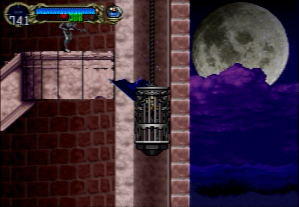That doesn’t hold a candle to the fact that most fights are partitioned off which drags any momentum you might have for exploration (at least the first time you’re in an area. Return trips don’t unnecessarily block you from proceeding) to a halt. I get that MercurySteam really wanted to find a way to blend Lords of Shadow with Metroidvania, but forcing players to stop in their tracks so they can fight a few enemies with their hack battle system is both boring and broken. It also robs players of choice. In exploration-heavy games like this (tries to be), you really don’t have to fight much of anything if you don’t want to, other than bosses. Sure, it makes sense that you would so you can build levels to make these eventual boss-walls easier to conquer, but they’re not necessary. What’s important in the post-Symphony of the Night games is that you mill around the environment to either find the next location to explore, obstacle to overcome, or secret to uncover, not delivering beatdowns to skeletons. In those games, you can decide if you want to grind for levels/gear/souls or to uncover your next destination, and these can be mutually exclusive. Not in Mirror of Fate where it’s enter into hallway, stop and fight, look around, stop and fight, enter next hallway. That got old fast.

But this game wasn’t the butt smear that certain corners of the intertron are calling it, either. Of the last several games bearing the name, I think that this one has some of the most consistent art direction since the NES era. While I’ll agree that dungeons and caves eventually look a little same-y, I find the tone consistent in lighting and mood, which is something that a lot of the other games just didn’t do. For as much as the audiovisual experience this series gets so much attention, it has always created a sort of cognitive dissonance between levels. Think about going from the Outer Wall in Symphony of the Night to the Library. The muted color tones and string-heavy music jerk into brightly colored décor and a harpsichord. Individually, they’re both brilliant. One right after the next is still jarring to me. It isn’t always like this. The bleak aesthetic of the Abandoned Mine a little later followed by the Catacombs is the perfect example of how everything fits together which is something that I’m guessing MercurySteam wanted to recapture with specific sections of Mirror of Fate, especially since the Catacombs is very platform-heavy.
I didn’t find the plot convoluted, though, which might make me a minority. In fact, I thought that the way MercurySteam reconciled strands of the previous continuity’s lore and brought them together was pretty agreeable. I’m probably going to SPOIL some things for you if you care (though you probably shouldn’t), but making Trevor into Alucard makes a hell of a lot more sense than in the previous continuity. Be with me for a second; Dracula, whom is the corporeal Prince of Darkness, decides to put aside being the World’s Ultimate Evil Satan figure for a brief moment so he could fall in love with a human woman named Lisa and knock her up. Then he goes back to be the World’s Ultimate Evil. This is pretty close to the dumbest origin I’ve ever heard, because brief lapses in defining character traits are about as clever as a fart joke. If you need further proof I have some Red Kryptonite for you. Though probably equally hackneyed, the idea of Gabriel Belmont having a secret son spirited away from him at birth and turned into a vampire later to save his life is a teensy bit more plausible. There certainly was a feeling of anticlimax after Mirror of Fate ended, but it did a fine enough job squeezing Trevor/Alucard and Simon into a continuity that doesn’t really need them to begin with. Which should be good enough, but I know for most people probably isn’t, so I’ll go ahead and drop it.
It’s an ok game, I guess. I’m a little let down that I threw forty clams at it when it only took a couple of sit-downs to finish, but I knew that coming in so shame on me. I still have some hopes for Lords of Shadow 2, but a whole lot less out of Konami if further handheld games in this series follow this same format. Points go to MercurySteam for trying something a little different from all things IGA, but not enough for me to place it among the better games in the franchise.


No comments:
Post a Comment